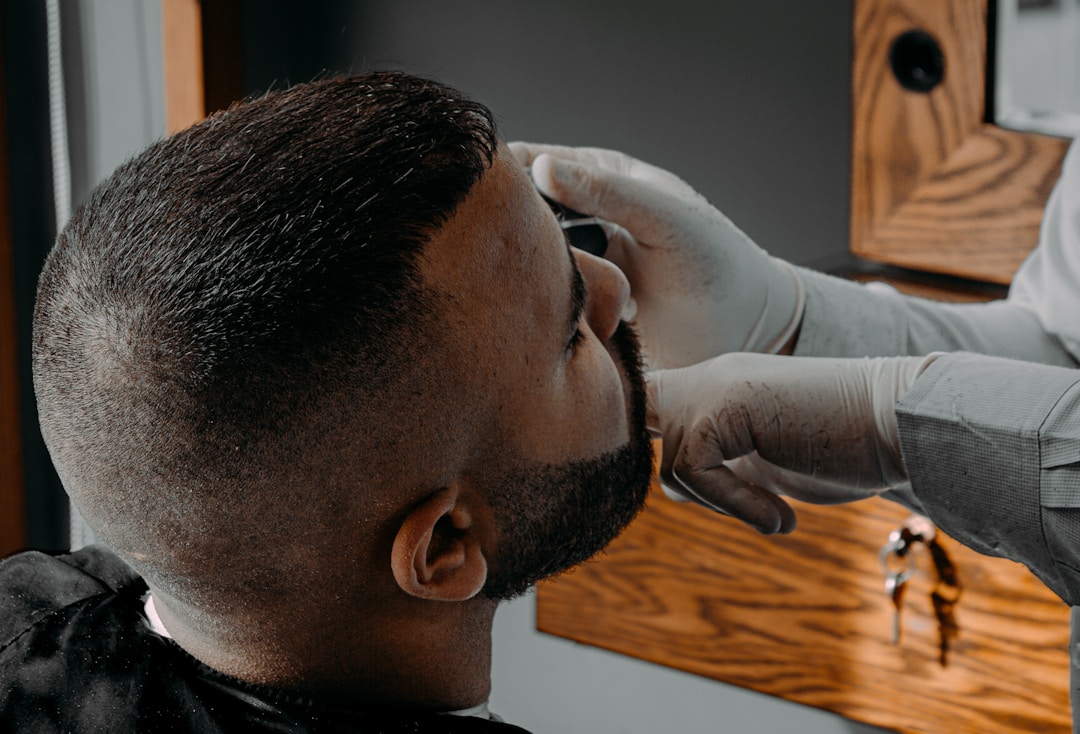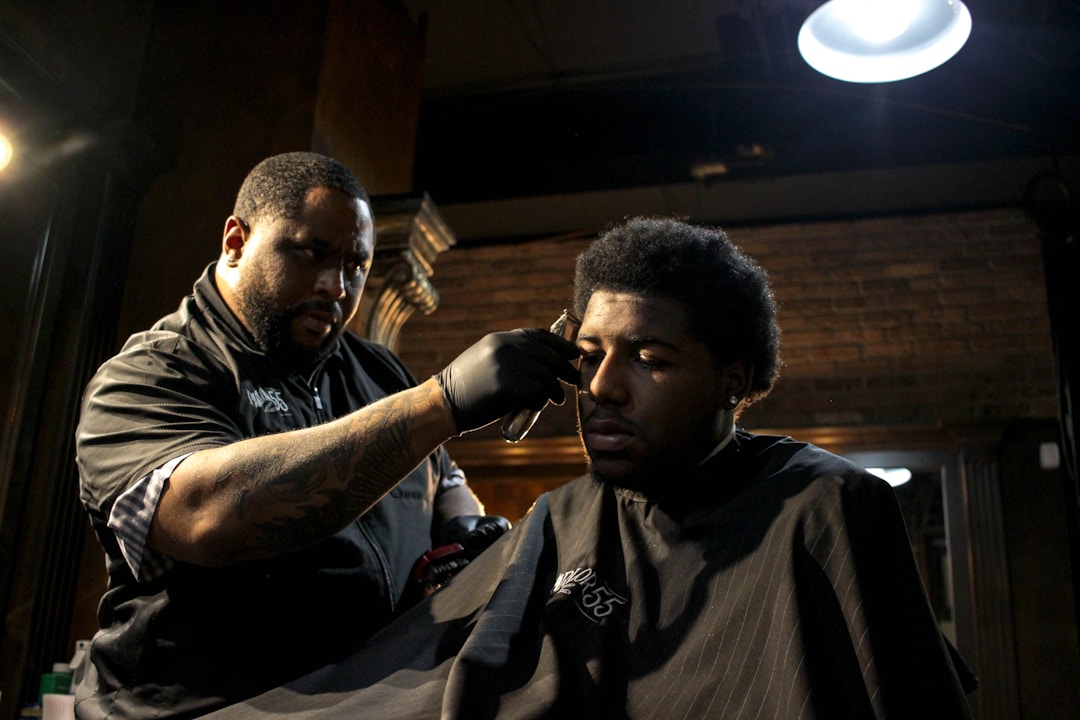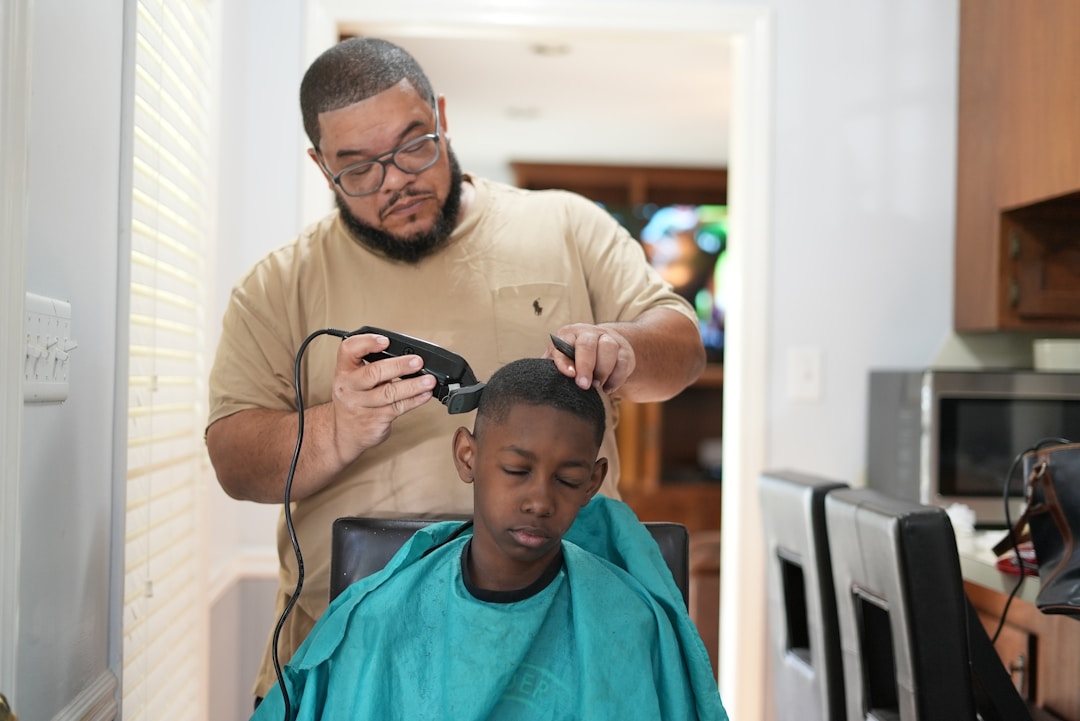Low Fade Haircut for Black Men: Complete Guide 2025
Master low fade haircuts for Black men with specialized techniques for textured hair. Cultural barbering experience, styling methods, and product recommendations from Queens NYC professionals.

The low fade haircut holds a special place in Black barbering culture, representing both technical mastery and cultural expression. For Black men with textured, coily, or kinky hair, the low fade offers a versatile foundation that works with natural curl patterns while creating clean, defined contrast that showcases the barber's skill and the client's personal style.
Understanding the unique characteristics of Black hair - its density, curl pattern, growth direction, and moisture needs - is essential for achieving exceptional low fade results. This complete guide covers specialized cutting techniques, cultural styling traditions, product recommendations, and maintenance strategies tailored specifically for Black men seeking the perfect low fade haircut.
Understanding Textured Hair and Low Fade Techniques
Black hair's unique characteristics create both opportunities and challenges for low fade haircuts. The natural density and curl pattern of textured hair allows for dramatic fade contrasts, but requires specialized techniques that differ significantly from approaches used on straight or wavy hair.
1. Coily/Kinky Texture (Type 4 Hair)
Tight curl patterns create natural volume and density. The hair grows in various directions, requiring careful attention to growth patterns during fade execution.
Fade Impact: Creates bold, defined transitions with high contrast between lengths
2. Natural Density and Volume
Black hair typically has higher density per square inch, creating fuller appearance even at shorter lengths. Hair grows outward as well as upward.
Fade Impact: Fades can appear to grow out faster as volume increases; requires more frequent maintenance
3. Lower Moisture Retention
The coily structure makes it harder for natural scalp oils to travel down the hair shaft, leading to drier hair that requires intentional moisturizing.
Fade Impact: Proper moisture management during and after cutting prevents irritation and maintains hair health
4. Versatile Curl Patterns
Within Black hair, there's significant variation from loose curls (3c) to tight coils (4c), each responding differently to cutting techniques.
Fade Impact: Barbers must adjust techniques based on specific curl pattern for optimal blending
5. Prone to Razor Bumps
The curved hair follicle structure makes Black hair more susceptible to ingrown hairs and razor bumps (pseudofolliculitis barbae) when cut very short.
Fade Impact: Requires careful technique choices, proper tools, and aftercare to prevent irritation
6. Strong Cultural Styling Traditions
Black barbering includes rich cultural practices like waves, edge-ups, temp fades, and specific terminology that reflects community heritage.
Fade Impact: Cuts often incorporate cultural elements that have specific meanings and aesthetic standards
Popular Low Fade Styles for Black Men
Low fades for Black men encompass a diverse range of styles that honor cultural barbering traditions while allowing for personal expression. These styles work with natural hair texture to create striking, culturally-rooted aesthetics.
Temp Fade with 360 Waves
Cultural Significance: Iconic style in Black barbering | Maintenance: High (daily brushing)
The temple fade (temp fade) concentrates the fade at the temples while maintaining waves throughout the top and sides. This style requires dedicated wave training through brushing, pomade, and durag use. The low fade creates clean contrast that makes wave patterns stand out prominently.
Wave Development: Brush 20-30 minutes daily with wave pomade, durag overnight for training, maintain moisture with natural oils, edge-up every 1-2 weeks for crisp definition.
Low Drop Fade with High-Top
Cultural Significance: Modern revival of classic 80s/90s style | Maintenance: Moderate
A bold statement style featuring significant height on top with a low drop fade that curves behind the ears. The natural volume of coily hair creates impressive height (3-6 inches), while the fade provides sharp contrast. Perfect for making a confident style statement.
Styling: Shape high-top with pick or Afro comb, use moisturizing products for definition, maintain fade every 1-2 weeks, trim top every 4-6 weeks for shape maintenance.
Classic Low Fade with Short Natural
Best For: Professional environments, versatile styling | Maintenance: Moderate
A versatile, professional style featuring a clean low fade with 1-2 inches of natural texture on top. Works for all face shapes and professional settings while maintaining natural hair character. Easily styled or left natural for low-maintenance appeal.
Styling Options: Brush forward for textured look, apply curl cream for definition, use edge control for hairline, or leave natural for effortless aesthetic. Refresh fade every 2 weeks.
Low Taper Fade with Afro
Cultural Significance: Celebrates natural hair texture | Maintenance: Moderate to High
Combines the volume and beauty of a natural Afro with the clean definition of a low taper fade. The fade provides structure while the Afro showcases natural curl patterns. Requires moisture management and regular shaping to maintain desired form.
Afro Care: Moisturize daily with water-based sprays, use natural oils for nourishment, shape with Afro pick, protect at night with satin bonnet, trim fade every 1-2 weeks for clean look.
Low Burst Fade with Curls
Best For: Modern edge, emphasizing curl pattern | Maintenance: Moderate
A contemporary style where the fade "bursts" around the ear, creating a curved fade line rather than straight. Works exceptionally well with defined curls on top, creating a modern, stylish look that emphasizes natural curl patterns.
Curl Enhancement: Use curl-defining cream or gel, finger-coil method for definition, maintain moisture with leave-in conditioner, preserve curls at night with satin/silk materials.
Low Fade with Twists or Locs
Cultural Significance: Protective styling with clean aesthetic | Maintenance: Low (daily) / High (installation)
Combines protective styling (two-strand twists, mini twists, or starter locs) with a clean low fade. Offers hair health benefits through protective styling while maintaining a groomed, intentional appearance with the fade's clean lines.
Maintenance: Retwist roots every 4-6 weeks, maintain fade every 1-2 weeks, keep twists/locs moisturized, refresh edges weekly for crisp definition.
Specialized Cutting Techniques for Black Hair Low Fades

Cutting textured, coily hair requires specialized techniques that differ from methods used on straight or wavy hair. Experienced barbers who understand Black hair use approaches that work with natural curl patterns while creating clean, defined fades.
Working with Growth Patterns
Understanding Directional Growth
Black hair often grows in multiple directions - not uniformly backward like straight hair. Professional barbers must identify growth patterns (whorls, cowlicks, directional changes) and adjust cutting angles accordingly.
- Crown Area: Often features circular growth patterns requiring radial cutting approach
- Temple Region: May grow forward or at angles, requiring careful attention for clean temp fades
- Nape Area: Can have opposing growth directions that need individual assessment for smooth blending
- Technique Adaptation: Barbers work against, with, and across grain as needed for optimal results
Clipper Techniques for Coily Hair
Specialized Clipper Work
Textured hair requires different clipper approaches than straight hair. The density and curl pattern mean barbers must use specific techniques to achieve smooth blends.
Open vs. Closed Blade Techniques
Using open and half-open blade positions creates subtle length variations essential for smooth blending in dense hair. This allows for more granular control than guard changes alone.
Flicking Motion
A signature technique in Black barbering where clippers are "flicked" outward at the end of each stroke, preventing hard lines and creating natural-looking blends.
Multiple Angle Passes
Due to varied growth directions, barbers make multiple passes from different angles (horizontal, vertical, diagonal) to ensure complete coverage and smooth blending.
Clipper-Over-Comb
Essential technique for blending the transition zone between fade and longer length, allowing precise control in the critical blend area.
Edge-Up and Line-Up Techniques
Defining Hairline and Shape
The edge-up (or shape-up/line-up) is a defining element of Black barbering that creates sharp, clean hairline definition. This technique is integral to low fade haircuts and requires specialized skill.
Natural Hairline Respect
Skilled barbers improve natural hairline shape rather than creating artificial lines. They consider face shape, hair density, and client preferences while maintaining realistic, sustainable edges.
Tool Selection
Professional use detailers, trimmers, or straight razors depending on client sensitivity and desired sharpness. Many Black men prefer clippers over razors to reduce razor bump risk.
Temple Design
Creating clean, sharp temple points is an art form in Black barbering. Angles and shapes are customized to complement face shape and personal style preferences.
Skin Preparation
Proper prep with pre-shave oils and working in direction of growth minimizes irritation - critical for preventing razor bumps in edge-up work.
Essential Products for Black Men's Low Fade Maintenance

Maintaining healthy hair and scalp while keeping your low fade sharp requires products specifically formulated for textured hair. Black hair's lower moisture retention means product selection focuses heavily on hydration and nourishment.
1. Wave Pomade or Brush Cream (For Wave Development)
Water-based pomades designed for wave training and definition
Usage: Apply to damp hair, brush in wave pattern for 20-30 minutes, durag overnight for training
Popular Types: WaveBuilder, Murray's, Sportin' Waves
2. Moisturizing Hair Cream or Butter
Rich, nourishing creams for natural styles, twist-outs, and daily moisture
Usage: Apply to damp or dry hair daily, focus on ends and lengths, small amounts for moisture retention
Key Ingredients: Shea butter, coconut oil, mango butter
3. Edge Control or Edge Tamer
Strong-hold gel specifically for hairline and temple definition
Usage: Apply to edges with soft brush, smooth down for crisp definition, use daily or as needed
Note: Choose alcohol-free formulas to prevent dryness
4. Natural Oils (Coconut, Jojoba, Argan)
Essential for scalp health and hair moisture, especially in fade areas
Usage: Apply to scalp and hair 2-3 times per week, massage into fade areas to prevent dryness
Benefits: Prevents flaking, promotes healthy growth, adds natural shine
5. Leave-In Conditioner
Lightweight moisture that stays in hair for ongoing hydration
Usage: Apply to damp hair after washing, focus on longer sections, don't rinse out
Perfect For: Natural styles, afros, twists, maintaining moisture between washes
6. Curl Defining Cream or Gel
For enhancing and defining natural curl patterns
Usage: Apply to wet/damp hair, scrunch or finger-coil for definition, let air dry or use diffuser
Results: Defined, separated curls with reduced frizz
7. Sponge Brush (for Curl/Coil Enhancement)
Creates defined coil patterns and texture through circular motion
Usage: Use on damp hair with curl product, circular motions to create uniform coil pattern
Style: Popular for achieving defined, textured looks with low fades
8. Durag or Wave Cap
Essential for wave training and style preservation
Usage: Wear after brushing waves or before bed to maintain patterns, protects edges
Material: Silk or satin for best results and moisture retention
Daily Hair Care Routine
Morning Routine (5-10 minutes)
- Remove durag/wave cap carefully to preserve patterns
- Moisturize hair and scalp with water-based spray or light oil
- Brush or style according to your look (waves: brush in pattern; natural: pick/finger-style; curls: define with product)
- Apply edge control to hairline and temples for crisp definition
- Final touches with styling product if needed for hold and definition
Evening Routine (3-5 minutes)
- For waves: Apply wave pomade, brush 20-30 minutes in pattern, apply durag
- For natural/curls: Apply light moisture spray, protect with satin/silk bonnet or pillowcase
- For twists/locs: Moisturize as needed, cover with satin bonnet to prevent frizz
- Scalp care: Massage fade areas with natural oil to prevent dryness and flaking
Low Fade Maintenance Schedule for Black Men
Consistent maintenance is critical for Black men's low fades. The natural volume growth of textured hair means fades can lose definition quickly, requiring more frequent professional attention than straight hair fades.
| Frequency | Service/Task | Details |
|---|---|---|
| Daily | Hair care routine, styling, moisture | Brushing (waves), moisturizing, edge control application |
| Weekly | Deep conditioning, scalp treatment | Wash, condition, oil treatment for moisture retention |
| Every 1 Week | Professional fade refresh (optimal) | Keeps fade and edges at sharpest, most defined appearance |
| Every 2 Weeks | Professional fade refresh (standard) | Maintains clean look while balancing cost and convenience |
| Every 4-6 Weeks | Twist/loc retwist, top length adjustment | For protective styles; maintain fade separately every 1-2 weeks |
Note on Frequency: Many Black men maintain sharp fades with weekly barbershop visits. While bi-weekly appointments work, weekly visits keep edges crisp and fade gradients clean. The investment in frequent maintenance is what creates the consistently polished appearance characteristic of excellent Black barbering.
Preventing Razor Bumps and Skin Irritation
Razor bumps (pseudofolliculitis barbae) are a common concern for Black men with coily hair. The curved hair follicle structure makes ingrown hairs more likely when hair is cut very short. Prevention requires proper technique and aftercare.
During the Haircut:
- Request clippers instead of straight razors for tight fade areas
- Ask barber to cut with the grain (direction of growth) when possible
- Ensure barber uses clean, sharp blades (dull blades increase irritation)
- Request pre-shave oil application before edge-up work
Immediately After Haircut:
- Apply alcohol-free aftershave balm or soothing gel
- Use products with witch hazel, tea tree oil, or aloe vera for calming
- Avoid touching or scratching freshly cut areas
- Apply cold compress if experiencing immediate irritation
Daily Home Care:
- Moisturize fade areas daily with natural oils or fragrance-free lotion
- Exfoliate gently 2-3 times per week to prevent ingrown hairs
- Use products with salicylic acid or glycolic acid for prevention
- Maintain clean pillowcases (change 2-3 times weekly)
- Avoid tight headwear immediately after fresh cuts
If Bumps Develop:
- Do not pick, squeeze, or attempt to extract ingrown hairs
- Apply warm compress to soften skin and encourage hair release
- Use specialized bump treatment products with salicylic acid
- Consider extending time between haircuts to allow healing
- Consult dermatologist if bumps are severe, infected, or persistent
Related Low Fade Resources
Frequently Asked Questions
Expert Low Fade Haircuts for Black Men
Visit DIDA Hair Studio in Queens, NYC for professional low fade haircuts by barbers experienced with textured, coily, and kinky hair. We specialize in cultural barbering traditions, precision fades, and maintaining the health of Black hair.